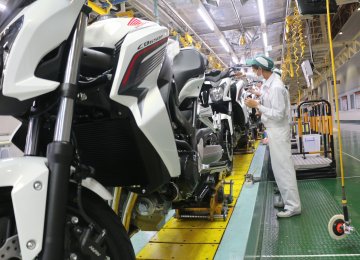Manufacturing conditions across Southeast Asia took a dive in October, with the Nikkei ASEAN Manufacturing Purchasing Managers’ Index hitting an 11-month low of 49.2, down from 50.5 the previous month. A reading above 50 indicates expansion, while anything below signals contraction.
Leading the plunge is Indonesia—the bloc’s largest economy—whose PMI skidded down to 48.7 in October, snapping a two-month improvement streak. A fall in new orders was the main reason for the drop, Nikkei reported.
Almost one-fifth of those interviewed said they had seen less new business, citing “subdued demand” and “unfavorable weather conditions,” according to IHS Markit, the London-based intelligence service provider that compiled the report.
The fall was more domestic than external, as the drop in overseas orders, which stood at 49.8 in October, was relatively moderate. “I think this is an indication of weakness in economic activity,” said Kunal Kundu, economist at Societe Generale. “Budget deficit concern is leading to curtailment of government expenditure. My guess is we will see public capex being cut to ensure budget deficit does not exceed 2.9% of gross domestic product.”
Kundu added that “with the festival-led domestic consumption likely to have waned, the manufacturing weakness is not a surprise.”
Bank Indonesia had recently slashed the benchmark repurchase rate to 4.75%—the sixth cut this year. “We expect the rate cuts thus far to have limited impact in the short term as banks are facing asset-quality deterioration, which causes them to be conservative and keep high risk premiums,” said Trinh Nguyen, senior economist at Natixis. “Also, demand for loans is low as global trade remains weak and commodity prices remain subdued.”
Thai Economy in Doldrums
Manufacturing in Thailand, the bloc’s second-largest economy, remained in the doldrums. Its PMI deteriorated for the sixth consecutive month in October, with all metrics except for input prices treading water.
The slump in new orders, which came at the sharpest rate since the initiation of the survey 11 months ago, was accompanied by accelerated layoffs and a more cautious inventory strategy by manufacturers. Some producers said that weaker consumer confidence, exacerbated by the king’s death, had made clients more reluctant to invest.
To stimulate demand, Thai producers cut selling prices for the first time in eight months despite rising input costs, according to Bernard Aw, economist at IHS Markit. The latest PMI figures do not bode well for Thailand’s manufacturing industry, he said.
Myanmar Production Shrinks
Myanmar’s October PMI, though at a three-month high, remained below the boom-or-bust mark. Manufacturers continued to shrink their production, despite new orders growing for the first time since June.
More worrying is persistent retrenchment amid declining backlogs of work, which in October deteriorated to 34.3, the sharpest pace ever in the survey’s 11-month history.
Wrestling with rising input costs, stemming from raw materials shortages and surging staff wages, Myanmar producers raised their selling prices at the quickest pace this year—which could create a negative feedback loop in the economy.
India Advances
India’s manufacturing delivered a 22-month high reading of 54.4 in October on the back of stronger new orders, output, and purchasing activities.
“While this is a positive sign, it may have been boosted by temporary factors, such as festival-season demand and pay commission hikes, which warrant caution,” said Sonal Varma, an economist at Nomura, who expects India’s economic growth to be largely unchanged at 7.3% this year.
Meanwhile, economic think-tank NCAER has pegged India’s GDP growth at 7.6% for the current fiscal on back of pick-up in rural demand and “positive signals” on the manufacturing front. India’s economy had expanded at 7.6% in 2015-16.
It said the anticipated improvement in the agricultural sector and the associated increase in rural demand will give an upward push to economic growth.
The manufacturing sector is also giving positive signals with Purchasers’ Managers Index, Index of Industrial Production for core sectors and auto sales going up. The domestic aviation sector growth too continues to be robust.






Add new comment
Read our comment policy before posting your viewpoints